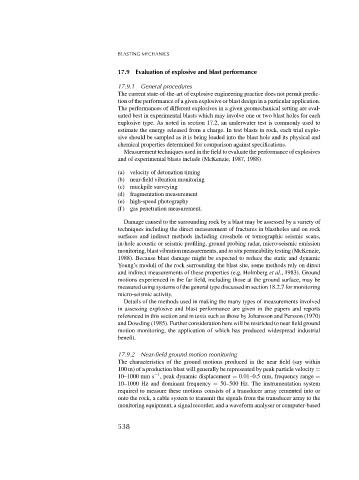Page 556 - Rock Mechanics For Underground Mining
P. 556
BLASTING MECHANICS
17.9 Evaluation of explosive and blast performance
17.9.1 General procedures
The current state-of-the-art of explosive engineering practice does not permit predic-
tion of the performance of a given explosive or blast design in a particular application.
The performances of different explosives in a given geomechanical setting are eval-
uated best in experimental blasts which may involve one or two blast holes for each
explosive type. As noted in section 17.2, an underwater test is commonly used to
estimate the energy released from a charge. In test blasts in rock, each trial explo-
sive should be sampled as it is being loaded into the blast hole and its physical and
chemical properties determined for comparison against specifications.
Measurement techniques used in the field to evaluate the performance of explosives
and of experimental blasts include (McKenzie, 1987, 1988)
(a) velocity of detonation timing
(b) near-field vibration monitoring
(c) muckpile surveying
(d) fragmentation measurement
(e) high-speed photography
(f ) gas penetration measurement.
Damage caused to the surrounding rock by a blast may be assessed by a variety of
techniques including the direct measurement of fractures in blastholes and on rock
surfaces and indirect methods including crosshole or tomographic seismic scans,
in-hole acoustic or seismic profiling, ground probing radar, micro-seismic emission
monitoring,blastvibrationmeasurements,andinsitupermeabilitytesting(McKenzie,
1988). Because blast damage might be expected to reduce the static and dynamic
Young’s moduli of the rock surrounding the blast site, some methods rely on direct
and indirect measurements of these properties (e.g. Holmberg et al., 1983). Ground
motions experienced in the far field, including those at the ground surface, may be
measured using systems of the general type discussed in section 18.2.7 for monitoring
micro-seismic activity.
Details of the methods used in making the many types of measurements involved
in assessing explosive and blast performance are given in the papers and reports
referenced in this section and in texts such as those by Johansson and Persson (1970)
and Dowding (1985). Further consideration here will be restricted to near field ground
motion monitoring, the application of which has produced widespread industrial
benefit.
17.9.2 Near-field ground motion monitoring
The characteristics of the ground motions produced in the near field (say within
100 m) of a production blast will generally be represented by peak particle velocity =
−1
10–1000 mm s , peak dynamic displacement = 0.01–0.5 mm, frequency range =
10–1000 Hz and dominant frequency = 50–500 Hz. The instrumentation system
required to measure these motions consists of a transducer array cemented into or
onto the rock, a cable system to transmit the signals from the transducer array to the
monitoring equipment, a signal recorder, and a waveform analyser or computer-based
538

